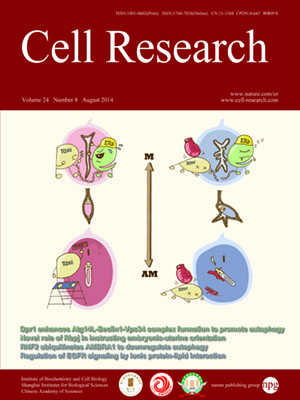
Volume 24, No 8, Aug 2014
ISSN: 1001-0602
EISSN: 1748-7838 2018
impact factor 17.848*
(Clarivate Analytics, 2019)
Volume 24 Issue 8, August 2014: 977-993
ORIGINAL ARTICLES
Tom70 serves as a molecular switch to determine pathological cardiac hypertrophy
Jun Li1,2,*, Man Qi1,3,*, Changming Li1,3,*, Dan Shi1,2,*, Dasheng Zhang1,2, Duanyang Xie1,3, Tianyou Yuan1,2, Jing Feng1,3, Yi Liu1,2, Dandan Liang1,2, Xinran Xu1,2, Jinjin Chen1,3, Liang Xu1,2, Hong Zhang1,2, Jiangchuan Ye1,3, Fei Lv1,3, Jian Huang1,3, Luying Peng4 and Yi-Han Chen1,2,3,4
1Key Laboratory of Basic Research in Cardiology of the Ministry of Education of China, East Hospital, Tongji University School of Medicine, Shanghai 200120, China
2Institute of Medical Genetics, Tongji University, Shanghai 200092, China
3Department of Cardiology, East Hospital, Tongji University School of Medicine, Shanghai 200120, China
4Department of Pathology and Pathophysiology, Tongji University School of Medicine, Shanghai 200092, China
Correspondence: Yi-Han Chen, Tel: +86-21-65989086; Fax: +86-21-65989086(yihanchen@tongji.edu.cn)
Pathological cardiac hypertrophy is an inevitable forerunner of heart failure. Regardless of the etiology of cardiac hypertrophy, cardiomyocyte mitochondrial alterations are always observed in this context. The translocases of mitochondrial outer membrane (Tom) complex governs the import of mitochondrial precursor proteins to maintain mitochondrial function under pathophysiological conditions; however, its role in the development of pathological cardiac hypertrophy remains unclear. Here, we showed that Tom70 was downregulated in pathological hypertrophic hearts from humans and experimental animals. The reduction in Tom70 expression produced distinct pathological cardiomyocyte hypertrophy both in vivo and in vitro. The defective mitochondrial import of Tom70-targeted optic atrophy-1 triggered intracellular oxidative stress, which led to a pathological cellular response. Importantly, increased Tom70 levels provided cardiomyocytes with full resistance to diverse pro-hypertrophic insults. Together, these results reveal that Tom70 acts as a molecular switch that orchestrates hypertrophic stresses and mitochondrial responses to determine pathological cardiac hypertrophy.
10.1038/cr.2014.94
FULL TEXT | PDF
Browse 2175


